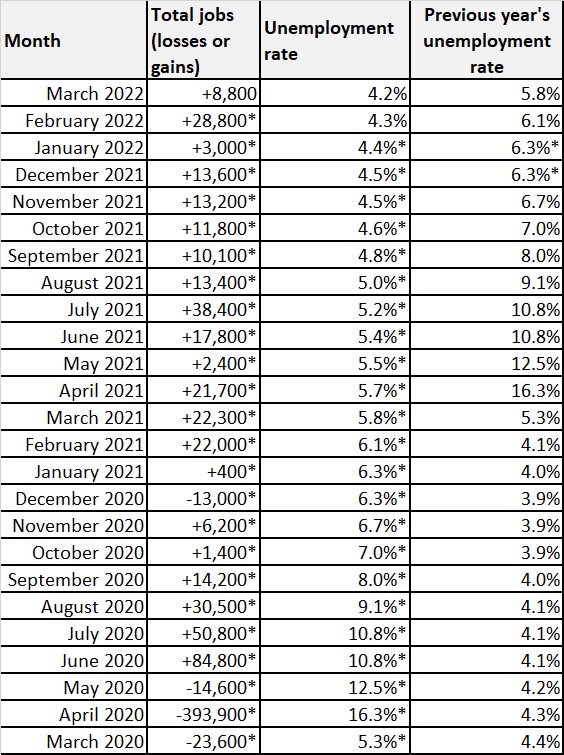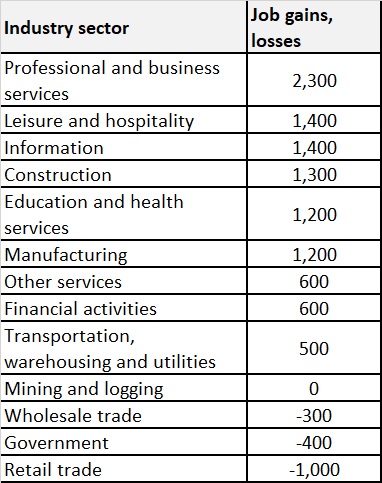Monthly Employment Report for March 2022
FOR IMMEDIATE RELEASE – April 13, 2022
Contact: media@esd.wa.gov
ESD Monthly Employment Report: Positive trend in hiring continues into March
OLYMPIA – Washington’s economy added 8,800 jobs in March.
“March marks the 15th straight month that jobs were added to Washington payrolls,” said the Employment Security Department’s (ESD) Economist Paul Turek. “Total nonfarm employment is now at 30,300 jobs, or just under 1% below February 2020 pre-pandemic levels.”
Also in March, the preliminary seasonally adjusted monthly unemployment rate fell slightly to 4.2%.
The Monthly Employment Report also includes:
- Preliminary job estimates for March from the federal Bureau of Labor Statistics.
- Confirmation of the preliminary 4.3% unemployment rate for February.
- An adjustment to preliminary jobs data for February, with the estimated gain of 31,700 jobs revised downward to a gain of 28,000 jobs. The revised estimate represents a more accurate picture of developments in the job market for February by including additional information that was not available at the time of the previous month’s release.
ESD paid unemployment insurance benefits to 54,578 people in March, a decrease of 1,241 over the previous month. Decreases in claims from the construction and health care and social assistance sectors contributed to the overall decrease in paid claims over the month.
National unemployment rate
The national unemployment rate dropped from 3.8% in February to the preliminary rate of 3.6% in March. For comparison, the national unemployment rate (revised) for March 2021 was 6.0%.
Further improvement in labor supply supports hiring efforts
The state’s labor force in March was 4,003,500 – an increase of 21,700 people from the previous month. Labor force is defined as the total number of people, both employed and unemployed, over the age of 16. In the Seattle/Bellevue/Everett region, the labor force increased by 7,500 over the same period. From March 2021 to March 2022, the state’s labor force increased by 125,500 while the Seattle/Bellevue/Everett region increased by 49,300.
From February to March, the number of people who were unemployed statewide decreased from 170,100 to 166,200. In the Seattle/Bellevue/Everett region, the number of people who were unemployed decreased from 58,600 to 54,800 over the same period.
Of the industry sectors, in March:
- Nine expanded.
- Three contracted.
- One was unchanged.
Private sector employment increased by 9,200 jobs while government employment decreased by 400 jobs. The Table 2 shows a summary of the job gains and losses in all 13 industry sectors.
Annual payrolls expand for all industries
Washington gained an estimated 173,000 jobs from March 2021 – March 2022, not seasonally adjusted. Private sector employment rose by 5.9%, up an estimated 159,600 jobs, while public sector employment rose by 2.4%, up an estimated 13,400 jobs.
From March 2021 – March 2022, all 13 major industry sectors expanded
The three industry sectors with the largest employment gains year over year, not seasonally adjusted, were:
- Leisure and hospitality, up 63,700 jobs.
- Professional and business services, up 30,200 jobs.
- Government, up 13,400 jobs.
Table 1: Washington’s total jobs

*Revised from previous preliminary estimates. Preliminary monthly estimates for jobs losses or gains are based on a small Bureau of Labor Statistics payroll survey while actual figures reported the following month are based on a more complete survey.
Table 2: Job gains and losses by industry

Monthly Employment Report publication schedule for 2022
|
Preliminary data for the month of: |
State and Seattle Metropolitan Division data released |
All other county data released |
|
January 2022 |
March 2 |
March 8 |
|
February 2022 |
March 16 |
March 22 |
|
March 2022 |
April 13 |
April 19 |
|
April 2022 |
May 18 |
May 24 |
|
May 2022 |
June 22 |
June 28 |
|
June 2022 |
July 20 |
July 26 |
|
July 2022 |
Aug. 17 |
Aug. 23 |
|
August 2022 |
Sept. 14 |
Sept. 20 |
|
September 2022 |
Oct. 19 |
Oct. 25 |
|
October 2022 |
Nov. 16 |
Nov. 22 |
|
November 2022 |
Dec. 14 |
Dec. 20 |
|
December 2022 |
Jan. 18, 2023 |
Jan. 24, 2023 |
Labor market information
See more labor market information and tools, including interactive Tableau graphics, to highlight popular information and data.
WorkSource
Employment Security is a proud partner in the statewide WorkSource system, which provides employment and training assistance to job seekers and businesses. WorkSourceWA provides access to thousands of Washington jobs and other employment resources. WorkSource staff can connect job seekers with employers hiring right now in their community, identify training opportunities or help them brush up on application and interview skills. Job seekers and employers can find their nearest WorkSource center on the WorkSource office locator page.
U-6 unemployment rate
The U.S. Bureau of Labor Statistics (BLS) updated its “alternative measures of labor underutilization” for states to include annual averages for 2021. One such alternative measure is the U-6 rate, which considers not only the unemployed population in the official “U-3” unemployment rate, but also marginally attached workers and those employed part time for economic reasons. The U-6 rate is defined by BLS as the “total unemployed, plus all marginally attached workers, plus total employed part time for economic reasons, as a percent of the civilian labor force plus all marginally attached workers.” This U-6 measure measures the “unemployed, underemployed, and those who are not looking but who want a job.”
The Washington state U-6 unemployment rate for 2021 was 10.1%. This was lower compared to the 11.7% U-6 unemployment rate for the fourth quarter 2020 through the third quarter 2021.
The U.S. U-6 unemployment rate for 2021 was 9.4%.